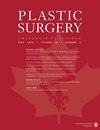Enhanced Recovery After Surgery in Immediate DIEP Flap Breast Reconstruction: Reducing Length of Stay and Opioid Use
IF 0.7
4区 医学
Q4 SURGERY
引用次数: 0
Abstract
Background: To improve patient outcomes amid reduced healthcare resources during the COVID-19 pandemic, a single Canadian cancer center implemented an Enhanced Recovery After Surgery (ERAS) protocol for autologous DIEP flap breast reconstruction. Methods: This retrospective cohort study included 100 consecutive patients undergoing microsurgical breast reconstruction with DIEP flaps using the ERAS protocol and 100 patients using a standard protocol. Primary outcomes were the hospital length of stay and opioid use. Secondary outcomes included postoperative complications, laxative and antiemetic consumption. Results: In this study, 80% of the patients had immediate reconstruction, while the remaining patients received either delayed immediate or delayed reconstruction. Patients in the ERAS group had shorter hospital stays (2.8 vs 4.5 days; P < 0.001) and lower total opioid use (50.2 vs 136.3 mg; P < 0.001). This reduction was also observed when breaking down opiates per day of hospitalization (30.2 vs 18.2 mg; P < 0.001), and in the first 24 postoperatively hours (35.7 vs 67.6 mg; P < 0.001). The control group had a higher incidence of postoperative complications, including seroma, partial and total flap necrosis, compared to the ERAS group. However, readmission rates were similar between the two groups. Conclusion: Implementing the ERAS protocol for DIEP flap breast reconstruction can significantly reduce hospital length of stay and postoperative opioid requirements without increasing the risk of adverse events. This pattern holds true for immediate reconstructions with DIEP flaps.加强即刻 DIEP 乳瓣乳房重建术的术后恢复:减少住院时间和阿片类药物的使用
背景:在 COVID-19 大流行期间,为了在医疗资源减少的情况下改善患者的治疗效果,加拿大一家癌症中心对自体 DIEP 乳瓣乳房重建术实施了术后强化恢复(ERAS)方案。方法:这项回顾性队列研究包括 100 名使用 ERAS 方案接受 DIEP 乳瓣显微外科乳房重建术的连续患者和 100 名使用标准方案的患者。主要结果是住院时间和阿片类药物使用量。次要结果包括术后并发症、泻药和止吐药用量。研究结果在这项研究中,80% 的患者接受了即刻重建,其余患者接受了延迟即刻重建或延迟重建。ERAS组患者的住院时间更短(2.8天 vs 4.5天;P <0.001),阿片类药物的总用量更少(50.2 mg vs 136.3 mg;P <0.001)。将阿片类药物按住院天数(30.2 对 18.2 毫克;P< 0.001)和术后头 24 小时(35.7 对 67.6 毫克;P< 0.001)细分,也观察到了这种减少。与ERAS组相比,对照组的术后并发症发生率更高,包括血清肿、部分和全部皮瓣坏死。不过,两组的再入院率相似。结论采用ERAS方案进行DIEP皮瓣乳房重建可显著缩短住院时间,减少术后阿片类药物的用量,同时不会增加不良事件的风险。这种模式适用于 DIEP 乳瓣的即刻重建。
本文章由计算机程序翻译,如有差异,请以英文原文为准。
求助全文
约1分钟内获得全文
求助全文
来源期刊

Plastic surgery
Medicine-Surgery
CiteScore
1.70
自引率
0.00%
发文量
73
期刊介绍:
Plastic Surgery (Chirurgie Plastique) is the official journal of the Canadian Society of Plastic Surgeons, the Canadian Society for Aesthetic Plastic Surgery, Group for the Advancement of Microsurgery, and the Canadian Society for Surgery of the Hand. It serves as a major venue for Canadian research, society guidelines, and continuing medical education.
 求助内容:
求助内容: 应助结果提醒方式:
应助结果提醒方式:


